| Trygve.Com > Images > "Weird World of Hardware" | Translate this page:
|
I don't usually wear one of these things Honest.
|
|
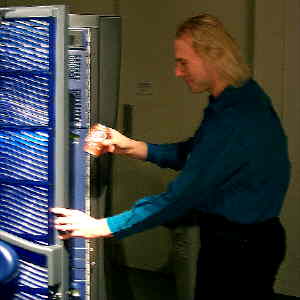
it's not just for storing soda in anymore |
Normally, even the coolest SGI workstations run pretty hot and their servers, well, if you used them for serving tea, you wouldn't have to worry about the tea cooling off in between cups. But at its debut, the Onyx 3200 ran cooler and quieter than any of SGI's previous offerings, mostly because the circuits to power this particular computational beast hadn't been installed. Ooops. Turns out that this model likes to have a couple of 220volt circuits all to itself, something one doesn't normally expect to see from anything other than large mainframes and Krell amplifiers. I have no idea whether Dan D'Agostino had been consulted in the design of the Onyx series. My guess is "not," but you can never be entirely sure about these things. |
My rather modest complement of SGI gear is more antiquated (the O2 and an Origin 200), but at least they can be run without modifications to the local power distribution system and the Origin 200 uses barely any more power than an ordinary handheld blow drier.
It's just that, with an Origin 200 server, you don't turn it off, so it keeps blowing, and blowing, and blowing....
|
|
So, at least for a while, the Onyx 3200 is operating as a dedicated awe-inspiring device, while the rendering and animation is performed by more menial processors, including the cute little box in the picture at left, which is currently sharing living quarters with its big blue cousin. |
It's not like I don't have my own share of imposingly monolithic computers that are presently dedicated to providing support for such diverse applications as vases, floral arrangements, and a lot of interesting minerals and fossils.
- and by "fossils," I do mean the "prehistoric life form" type, not something made by, say, Data General.
|
Here's one of a set of Netframe redundant computing systems that I have, which I believe had previously been used to operate the ill-fated original baggage-mishandling system at Denver International Airport. Whatever their failings might have been as automated conveyance controllers, they work pretty darned well as display stands and blend tastefully in with the neo-classical decor of the music room in a way that more state-of-the-art servers from Sun and SGI probably wouldn't. |
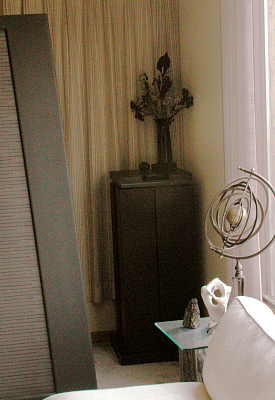
NetFrame redundant processor array |
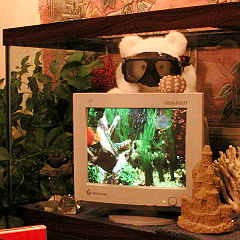
|
Of course, even smaller and less-imposing obsolete computers can still find a place in one's decorating style. In this case, an ageing laptop with a so-so screen and a long-dead battery is quite adequate to operate this "fishtank" screensaver with far lower maintenance than would be required to keep real water and fish in the tank. Especially if the monitor weren't removed or at least unplugged before filling the tank. The laptop itself would be safe, though; it's in the stand underneath the fishtank itself. |
|
But the uses for computing equipment aren't limited merely to tasteful home decorating. For starters, the sartorial applications of computer equipment are, if not endless, at least more than two. |

as featured in Geek's Quarterly |
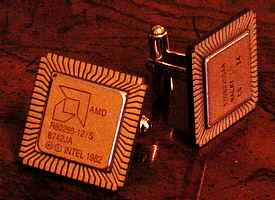
|
The Compaq Deskpro 286, for example, used this attractively-styled package for the 286, well-suited for making cufflinks such as these which--at least to anyone with a low geekiness quotient--look even more hi-tech than a 80286 processor really is. As Ben Scott once remarked, "It is not possible to simultaneously understand and appreciate the Intel architecture"--but to the casual computer user unfamiliar with the totally dorky way the 286 handled extended memory addressing (among other things), it looks great and won't make your date look like she's caught some horrible rash by the end of the evening the way that the newer Pin Grid Array processor pachages do. |
(BTW, the red-bordered studs shown in the photograph above are TO-220 heat sinks.)
One of the less obsolete arrivals out here on the Island of Misfit Servers (or "Leaf-Node," if you prefer) is "Tenaya," the almost mythical Sun Enterprise T3120 1U server:
Front view of the Sun Sparc Enterprise T3120 server |
Back view of the Sun Sparc Enterprise T3120 server |
Widely announced but never released, Tenaya was supposed to come out as a lower-cost alternative to Sun's family of pricier "Coolthreads" systems. Few people have ever seen one in person and lived to tell the tale, and there are precious few pictures of a real live T3120 to be found anywhere on the net, so I'm putting some up myself to change that.
Wrapped around Sun's second generation Niagara T2 processor, Tenaya sports 8 CPU cores, 64 simultaneous threads, 32GB FB-DIMM RAM, and a couple of expansion slots including a pair of low-profile x8 PCI-express slots and slots for a duet of Sun's flash modules (which I won't be getting unless I find an amazing deal on them) and, oh yes, an upward-facing USB port that's about half an inch below the cover justting upwards right in the middle of the mainboard. You could put one of those super-short USB drives on it--the kind that's barely bigger than the connector itself--but most USB drives, including all the ones shaped like cute animals, are not going to fit.
On top of Tenaya... |
...and a peek inside the enterprise |
A better look at the Sun Sparc Enterprise T3120 server motherboard |
You get only a single pair of gigabit ports (as opposed to the quartet found in the T1-based T1000 and T2000 boxes or the other T2-based T5120 and T5140 machines) and no 10GbE ports at all. But if your networking needs are modest enough, that can still be enough. To be fair, most of the computers--even the lastest and greatest ones--that you'll find in a typical Best Buy don't have 10GbE either. Even if it is a bit stripped down compared to the models that were actually released, packing 64 threads into a 1u case wasn't so bad, at least for its time.
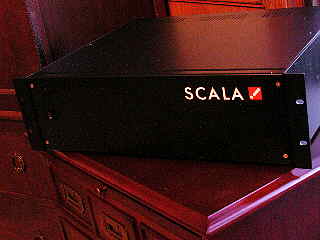
|
And speaking of packaging, one of the most interesting examples of repackaging is the Scala WS500xxx Video Workstation pictured here. As you can see, it has been designed with a sleek, black rack-mount enclosure for the ultimate in serious, professional video product appearance. |
|
However, if you remove the top cover, what's inside is a Commodore CD32 video gaming system (somewhat like an older version of the Sony Playstation, with an architecture drawing heavily from the Commodore Amiga), relabeled "Socrates Interactive Patient Education System" before being re-relabeled by Scala. |
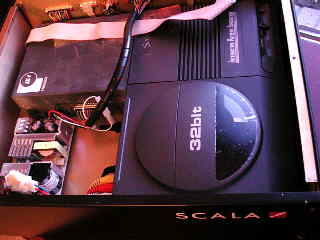
|
Um, the designer drank what...?
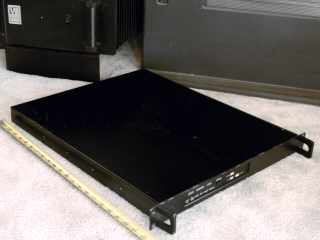
|
The "packaging that goes that extra mile" award (1U rack height category) goes to Dialogic for this interesting use of cabinet space, made possible through the miracle of ribbon cable. |
...the screwdriver, please....
|
Yes, in a mere 24" rack-mount cabinet, Dialogic was able to pack a full five (!) 74-series logic ICs and a DC-to-DC voltage converter. As you can see, the designers were not quite able to squeeze an AC power supply into this particular cabinet, so an external supply is needed to make this beast do whatever it is that it's supposed to do. |
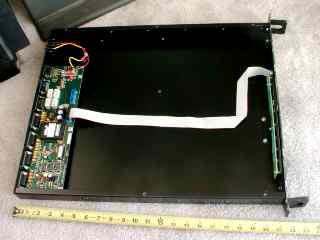
|
Fortunately, not so very far from the shelf in the home warehouse where the Dialogic box went back to, after its fifteen kilobytes of fame were uploaded, I happen to have a fine collection of wonderfully overbuilt power supplies that had been intended for the Fort St. Vrain nuclear power facility, but were never installed. They're a little bigger than most of the regulated power supplies I've built for my own analog design projects, but doesn't it give you a warm feeling somewhere deep inside when you know that the preamp you're using has a power supply approved for use in a nuclear power plant?
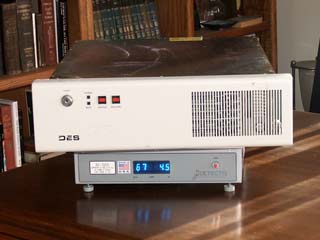
|
Not so long ago, there was no end of hullaballo over Western Digital coming out with hard drives with eight meg of cache memory. Eight meg isn't so special any more, but there's no need to stop there with a fabulous external drive cache like this 500-meg unit from Database Excellerator Systems (now Solid Data). |
|
Tipping the scale at more than 67 pounds, it's a little heavier than most hard drives you'd be likely to attach it to, but there's always some kind of price to be paid for performance. |
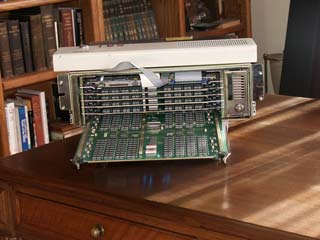 |
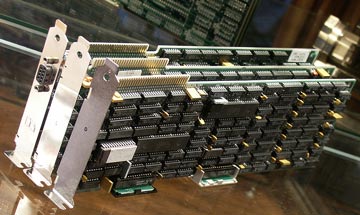
|
These days there are a few high-end gaming graphics cards where the heatsink takes up an extra slot, and even a few high-end workstation display cards that really do use two slots, but this super high-end IBM display card from 1985 is made up of three full-length cards. |
|
Unfortunately, there are few identifying marks on it and I haven't actually tried to fire it up yet, so I can't tell you how many frames per second this card will do running Quake, but I can tell you that it has a whole 8k of high-speed static RAM and no fewer than eighteen TMS4416-15NL chips, giving it a whopping 144K of 150ns DRAM. |
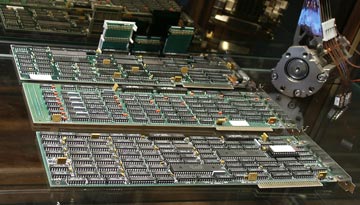 |
Update: I got a note from Lon <mymailpale@gmail-com> who writes:
I saw your pics of the super high-end IBM display card from 1985 that used 3 full slots and also curious on its performance. Heres what I dug up.
Introduced in 1984, and obsoleted by 1987, the Professional Graphics Controller (often called "Professional Graphics Adapter" and sometimes "Professional Graphics Array") offered slightly higher resolution and color depth than the EGA, up to 640 x 480 and 256 colours at 60 frames/second. It was intended for the computer-aided design market and included 320 kB of display RAM and an on-board microprocessor, which gave it the ability to do 3D rotation and clipping of images. While never widespread in consumer-class personal computers. US$4,290
Thanks, Lon!
It's funny to note that--thanks to Crossfire and SLI--the latest and greatest 3D video cards once again occupy multiple slots and employ a bridge connector. Bet they're a little faster, though.
|
But if I do set up a 1985 version of a PC-based graphic workstation, perhaps I'll see if I can get this Philips CM-100 CD-ROM drive working with it. |
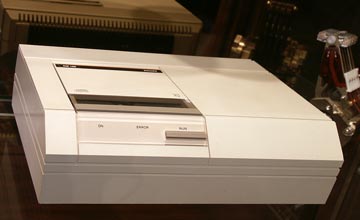 Philips CM-100 CD-ROM drive |
One worry, though--I'm not sure how well it'll work with CD-Rs. |
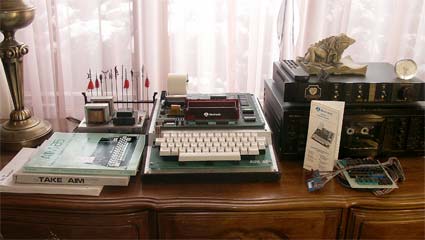 Rockwell AIM-65 computer |
Not all the computers here at the treehouse are advanced enough to use the CM-100 CD-ROM drive. This Rockwell AIM-65 computer, for example, dating from 1977. It features a 1MHz 6502 processor, 1K of RAM (expandable to 4K), a 20-character LED display, and a built-in printer, suitable for all your printing needs, as long those needs are limited to printing monochrome text no more than two inches wide. |
|
Some products suffer more from being a little too far ahead of their time, like this squadron of Philips CD-i 350 portable "compact disk interactive" players. |
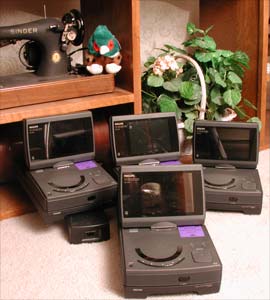 Philips CD-i 350 portable CDI players with digital video base |
You needed an add-on base (you can see it on these units) to be able to play video (MPEG-1). You could play CD-i disks on these, not unlike how you would use a portable DVD player these days, but to do that, somehow you'd have to locate or figure out how to author disks that it would play, and I've never gone to that much trouble. |
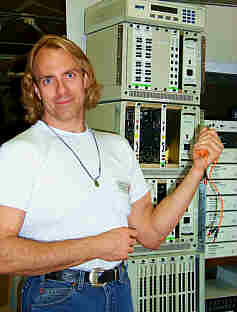 |
But the world of obsolete computer hardware isn't all glamor and excitement, no matter what you might think after reading too many issues of Better Homedirs and Networks. Sometimes you'll get something that looks great in the warehouse or salvage lot, get it home, and then decide it clashes with the drapes, doesn't work with the lines of the sectional, or uses a proprietary encapsulation standard. Such was the case (ahem) with a batch that included a dozen or two of these large Cabletron (now Enterasys) modular hubs. If the treehouse were carpeted in "builder beige" like so many homes are these days, they might have worked, but, no, somehow they just didn't have the right look. |
Even so, it's a good idea to have this kind of equipment on hand, just in case you happen to be hosting an international symposium less than sixteen hours after the film crew has finished shooting several movie scenes throughout your house--and at the last minute you find out that the network hardware for the computers to be used at the symposium hadn't been arranged for after all.
Admittedly, that's only happened to me once so far, but I figure, "better safe than sorry."
|
The biggest danger of furnishing your home with obsolete computer equipment is that you'll fill your home warehouse with too many of those things that just didn't quite work with the drapes after all. And with things like this Sequent mainframe, you've got the "dedicated 220 volt circuit" problem again. If I had a bigger laundry room, I could hook up a mainframe next to the clothes dryer, and that would probably work fine, at least as long as I kept the dryer in the "delicate-to-medium" range while the computer was running. |
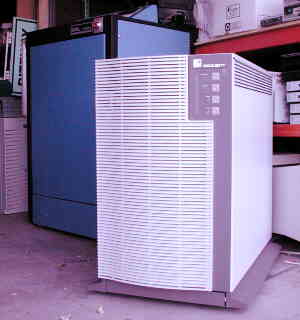 |
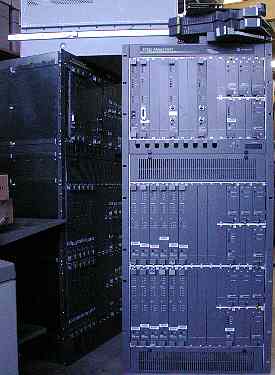 |
Then there are the things like these Newbridge / Alcatel 31650 and 3600 ATM / T-3 / OC-3 / T-1 / etc-3 switching racks. I know how easy it can be to forget that you don't have a moderate-sized South Pacific island to instal a telecommunications infrastructure on, but when you're not careful, you can end up with an aisle of these things. |
|
I guess I can always get a moderate-sized South Pacific island later and just store these until then. - either that, or find matching wallpaper for the study. Somebody has to have modular rack-mount-style wallpaper in industrial bluish-grey, don't you think? |
|